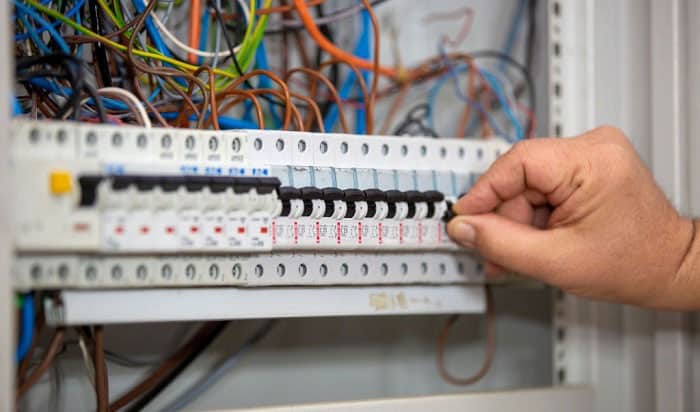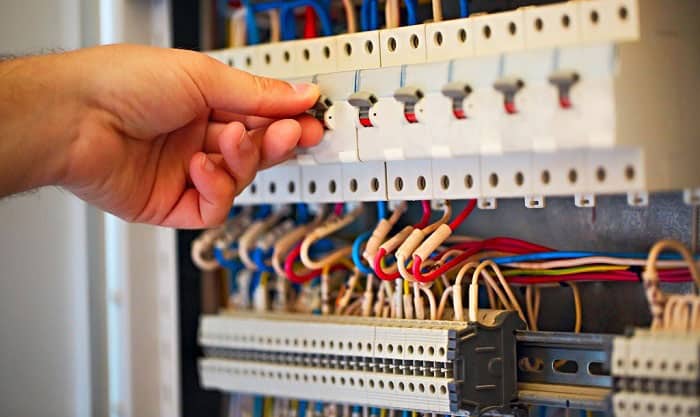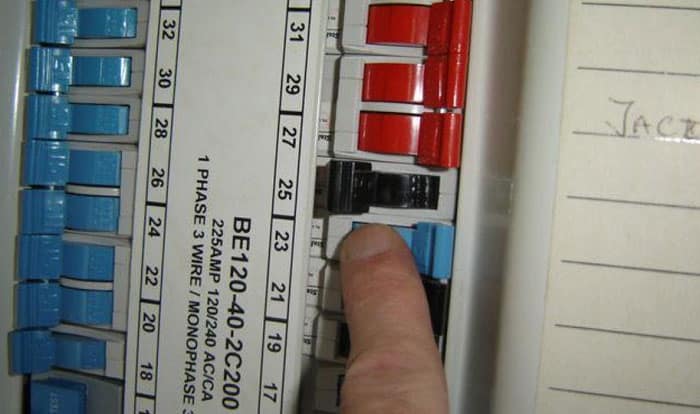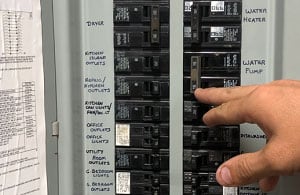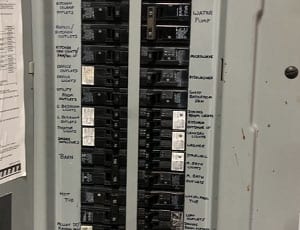Are you looking for a way to learn how to trip a circuit breaker deliberately while making sure you won’t damage your electrical system or the breaker itself? If you want to force a circuit breaker to trip without risking your property, turn it off through the panel.
You’ll need to plug in an appliance or turn on lights that are connected to the circuit and the corresponding breaker. Afterward, you need to turn off the breaker from the panel manually. Then, from there you have to check whether it tripped (turned off) as it should. I’ll explain more in the sections below.
Table of Contents
Things You’ll Need Before Starting
- The breaker you mean to test
- Safety glasses
- Insulated gloves
- Insulated screwdriver (If necessary)
A couple of safety tips before pushing through with this circuit breaker trip (pardon the pun):
- Keep your distance from wires and anything that might conduct electricity. Don’t be too confident that your safety equipment can protect you 100% of the time!
- Keep in mind that you’ll have to reset the breaker once you trip it intentionally. Be on the watch for electrical sparks when you’re attempting to do this. I suggest not directly facing the breaker when doing so.
- You may have the proper PPE. However, be mindful of factors such as moisture near the panel when handling it. Be sure everything, especially any spot near the panel, is dry before beginning, and don’t forget about your own body!
I don’t recommend purposely short circuiting the switch board or grounding the phase wire at all. Unless you have complete trust that your breaker will trip 100% of the time, don’t bother doing this since you not only risk starting a fire but also electrocuting yourself or anyone helping you.
If you’ve experienced a short circuit or a grounding issue recently and the breaker tripped, that should be a good sign the breaker is still in tip-top shape.
To actually force these electrical issues to happen just to find out whether the breaker is still functioning can make any professional electrician cringe, so I suggest you steer clear of even finding out ways to do them! Go for it if you want to short circuit your appliances and gadgets.
How to Deliberately Trip a Breaker
To safely trip a breaker, don’t depart from the following steps:
1. Leave the appliance, gadget, or light on if you know it is being protected by the breaker you’re attempting to trip.
Any of these three will do. Just make sure you don’t turn on too many of them, assuming you already have an existing overload problem that you haven’t solved yet.
Turning on an appliance being fed by a circuit connected to the breaker you’re trying to trip equates to opting to trip a breaker from an outlet. Incidentally, if you’re trying to trip an AFCI or GFCI outlet, you can do so by using the integrated reset button, This video demonstrates how to do it and gives a couple of helpful tips:
2. Go to the panel, open it then locate the breaker.
Of course, this is assuming you already know where it’s located. If you’re still unaware of this vital information, stop for now and contact your local electrician or electrical company to help you find it.
Want to skip this? Try to search for it in the basement or any utility room. It’s typically shaped like a rectangle and is attached to the wall. Use Google images as a reference.
Have you found the coveted box? Simply open it to look for the breaker. You may need to use a screwdriver to remove the cover.
3. Turn off the circuit breaker then check whether the appliances or lights you left on shut off, too.
Once you find the breaker, pull or push its ‘Off’ button. Again, you’re basically tripping the circuit breaker manually by doing this, which is a feature designed by the breaker’s manufacturer. With that in mind, doing this shouldn’t cause any issue, unlike forcing a short or ground to occur.
With the breaker in tripped position, go back to the room where you left the lights, gadgets, or appliances running. They should no longer be running, assuming the circuit and breaker are all aligned when you previously performed the steps. If that’s what happened, then congratulations, you successfully tripped the correct breaker!
Are You Still Trying to Find the Breaker or the Circuit Connected to It?
If you’re thinking that tripping the breaker deliberately is a good idea just to pinpoint where it’s located in a packed panel, there’s actually a far simpler way to do this.
In fact, this video explains everything you need to do, and what’s even better is that you don’t need to use any specialized tools to complete your search. It’s well worth watching for the valuable knowledge you can gain, that much I’m certain:
What if you’re trying to find the circuit being served by the breaker? If so, then you ought to buy a reliable circuit tracer instead. One benefit of using this tool is that you can safely perform your identifications without having to shut off the entire electrical system, which, in some cases, requires permission from local electrical authorities.
If You Want to Test a Breaker, There Are Far Safer Ways to Do It
Moreover, I’m going to assume that some of you are planning on tripping the circuit breaker because you’re trying to test if it’s still in working condition. If that’s the case, then you should learn the clues that point to a bad breaker. Check this guide to know how to test a bad breaker now!
Remember, if your circuit breaker tripped and is continuing to do so, the breaker itself may already need replacing. If you decide to trip a circuit breaker on purpose once you’re already having this problem, you’re only putting yourself and your home in greater danger. I suggest you call an electrician immediately if you think this is the issue.
Since there are many types of circuit breakers, there’s more than one way they fulfill their tripping mechanism. If you want to learn how to identify the circuit breaker type, I suggest you refer to the label that’s printed on the breaker itself. It should indicate whether it’s a single-pole vs double-pole, GFCI or AFCI.
Conclusion
Did you find my guide on how to trip a circuit breaker helpful? I recommended this procedure because it’s the only safe way to trip a circuit breaker. If you happen to know another way, please don’t hesitate to share it in the comments. I’d love it if you took the time to share this article, too.
Related posts you may be interested in:

I am Edwin Jones, in charge of designing content for Galvinpower. I aspire to use my experiences in marketing to create reliable and necessary information to help our readers. It has been fun to work with Andrew and apply his incredible knowledge to our content.

